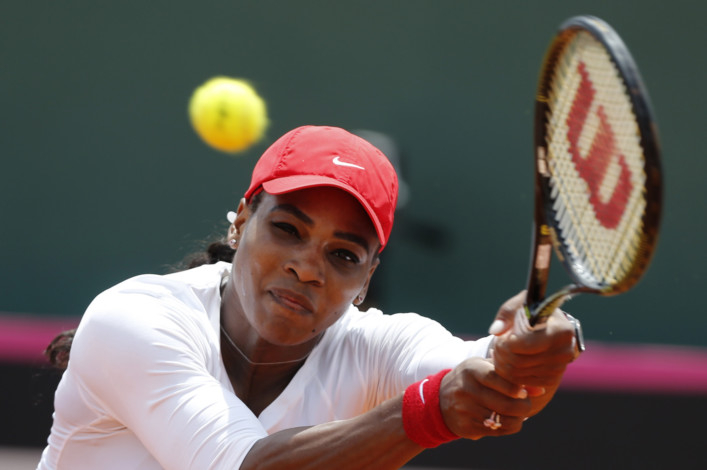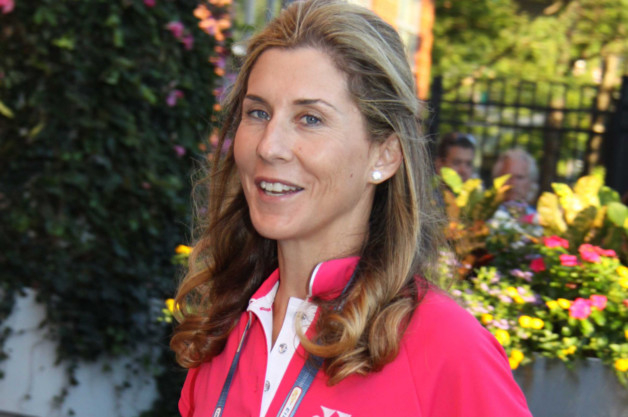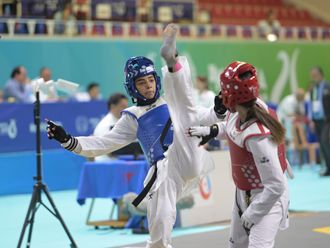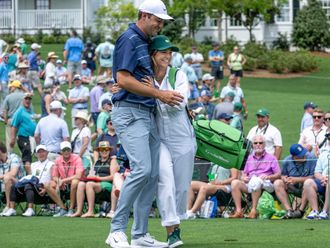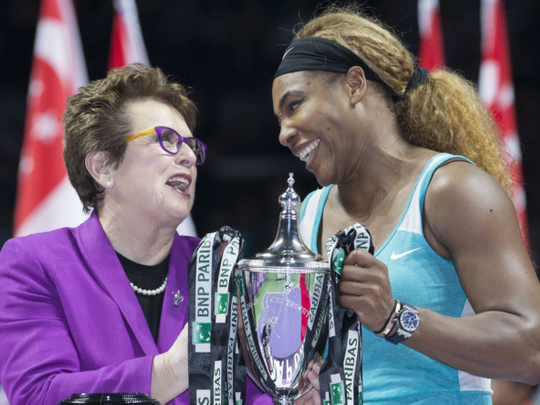
It’s the incident now known as ‘twirlgate’.
When professional tennis player Eugenie Bouchard stood in front of courtside reporter Ian Cohen at the Australian Open in Melbourne last month, she was unexpectedly asked “do a little twirl”.
Laughing, the Canadian player did as told, giving Cohen and the cameras a little spin.
“It was very unexpected,” she said of the incident. “An old guy asking you to twirl? It was funny.”
Others found the situation less than humorous, perhaps because it was an indication of the broader sexism that runs rampant among the world of professional sports. After all, it’s hardly imaginable that someone like Novak Djokavic or Roger Federer would be asked to give the lenses a show.
Bouchard, the No. 7 female tennis player in the world, had a different take on the situation, saying she and her friends had joked about it over text. She added that she’s fine with doing a twirl, just like men might be asked to show their muscles.
“Personally I’m not offended. No, I think it was an in-the-moment thing and it was funny. But, yeah, I mean, it’s just funny how it’s taken a life of its own. I’m just going to try to focus on my tennis,” she said.
But twirlgate doesn’t exist in a vacuum. Women’s tennis has been undermined over the years, with fellow athletes, reporters and members of the public diminishing its importance in comparison to men’s tennis. For years, the issue of equal prize money for men and women’s tournaments plagued the sport.
Three years ago, French player Gilles Simon famously argued against equal prize money for women, calling men’s tennis a more “attractive” game. He received backlash from big name players like Serena Williams and Maria Sharapova.
“No matter what anyone says, or the criticisms that we get, I’m sure there are a few more people that watch my matches than his,” said Sharapova.
Williams agreed. “We fought for years with Billie Jean King, and Venus [Williams] as well, really set the pattern on what we should do,” she said. “I started playing tennis at two years old. I’m sure he started when he was two years old, as well. I worked just as hard as he did.”
But gender issues don’t stop there.
At the Australian Open two years ago, French player Jo-Wilfried Tsonga said women “are more unstable emotionally than us.”
“I mean, it’s just about hormones and all this stuff. We don’t have all these bad things so we are physically in a good shape every time, and you are not. That’s it,” he said, as though it was simple biology that women weren’t as capable as men.
Ernests Gulbis, with a current No. 13 singles ranking, said he wouldn’t wish for his sisters to pursue professional tennis like he has. For him, women belong at home.
“A woman needs to enjoy life a little bit more. Needs to think about family, needs to think about kids. What kids you can think about until age of 27 if you’re playing professional tennis, you know. That’s tough for a woman, I think,” he said.
Certainly, former No. 1 American tennis player Jean King would disagree. As the Dubai Duty Free Tennis Championships gear up for a February 15 kick off, tabloid! highlights five women, including Jean King herself, who helped pave the path for their fellow athletes.
Billie Jean King, 71
In 1973, tennis icon Billie Jean King played the match of her life. Dubbed the ‘Battle of the Sexes’, she took on former world champion Bobby Riggs, who was then 55, and who claimed women’s tennis was so inferior he’d beat all of them even at that age. He lost.
“I thought it would set us back 50 years if I didn’t win that match,” King, who has won 39 Grand Slam titles, including 12 singles, 16 women’s doubles, and 11 mixed doubles titles, would recall to CNN years later. “It would ruin the women’s tour and affect the self esteem of all women.”
That same year, she formed the Women’s Tennis Association, and threatened to boycott the US Open if women players weren’t paid equal prize money as the men. She won and set off a precedent that would change women’s tennis forever.
Current world No 1 Serena Williams is still one of her top fans.
“Billie Jean has been my ultimate inspiration,” she said recently. “Not just women’s tennis but women’s sport would be greatly diminished if it wasn’t for Billie Jean.”
Martina Navratilova, 58
Shortly before her 19th birthday in 1975, tennis rising star Martina Navratilova defected to the US from Czechoslovakia, seeking a better future. Three years later, she won her first Grand Slam singles title at Wimbledon, becoming the world No 1 female tennis player for the first time. There was no stopping her from there: After successfully defending her title the following year, in 1979, she won the Australian open in 1981, the Wimbledon and French Open in 1982 and three of the four Grand Slam singles titles in 1983, quickly becoming the most feared female tennis player ever. By the time she properly retired in 2006, she had won 18 Grand Slam singles titles, 31 Grand Slam women’s doubles titles (an all-time record), and 10 Grand Slam mixed doubles titles.
In April, 2010, Navratilova announced to the world she was facing her toughest opponent ever: breast cancer. “When I first got the news, I was alone in my house. I was shocked, overwhelmed and devastated,” she told Good Morning America.
But by October that year, she announced she’d won again: “I am cancer-free. Technically I was cancer-free after the lumpectomy in March,” she told People magazine, adding: “‘I really didn’t talk much about breast cancer before I had it. Now, I’m approached by women and we share our stories. It’s encouraging to see that there’s life after cancer.”
Monica Seles, 41
At the age of 16, Monica Seles became the youngest ever French Open champion in 1990. In the following three years, she would go on to win eight Grand Slam singles titles, all before she turned 20. But everything changed tragically for the former Yugoslavia-born champ when she was attacked in 1993 by a crazed fan of Steffi Graf during a break match in Hamburg, Germany, effectively putting a halt on her meteoric rise. Security at tennis matches forever changed following the attack.
“I remember sitting there, towelling off, and then I leaned forward to take a sip of water, our time was almost up and my mouth was dry. The cup had barely touched my lips when I felt a horrible pain in my back,” Seles would later write in her 2009 autobiography Getting a Grip. “I saw a man wearing a baseball cap, a sneer across his face. His arms were raised above his head and his hands were clutching a long knife. He started to lunge at me again. I didn’t understand what was happening.”
Seles would not return to tennis for over two years. When she did, she enjoyed some success, including a fourth Australian Open success in 1996, but was unable to regain her form before her attack. She officially retired in 2008.
The scars would haunt her forever: “I was stabbed on court, in front of thousands of people,” she wrote in the autobiography. “It is not possible to talk about distancing yourself from that. It changed my career and irrevocably damaged my soul. A split second made me a different person.”
Venus and Serena Williams
“We changed tennis,” Serena Williams proclaimed to the media in 2013 in Argentina. “We brought passion and fashion wearing extravagant clothes. And also style, power as a new skin colour as we are African-Americans. We improved tennis.”
It would be easy to argue with the younger Williams sister and current world No 1, if her claims weren’t true. Often referred to as the greatest player in tennis history, Serena has 19 Grand Slam singles to her name and 13 Grand Slam doubles with her sister. Venus, who became the first American black woman to be world No 1 in the Open Era in 2002, has seven Grand Slam singles titles.
But these boundary-redefining champions’ influence goes way beyond their mastery of the game, cementing their positions as not only sport, but cultural icons for a generation. They’ve consistently re-energised race debates in sport, spurred discussions about stereotypes of female beauty and are both serial entrepreneurs making their mark in TV, fashion, literature and many charitable projects. That they are still on top of their sporting game is only an added advantage. They don’t call it the Williams Effect for nothing.


